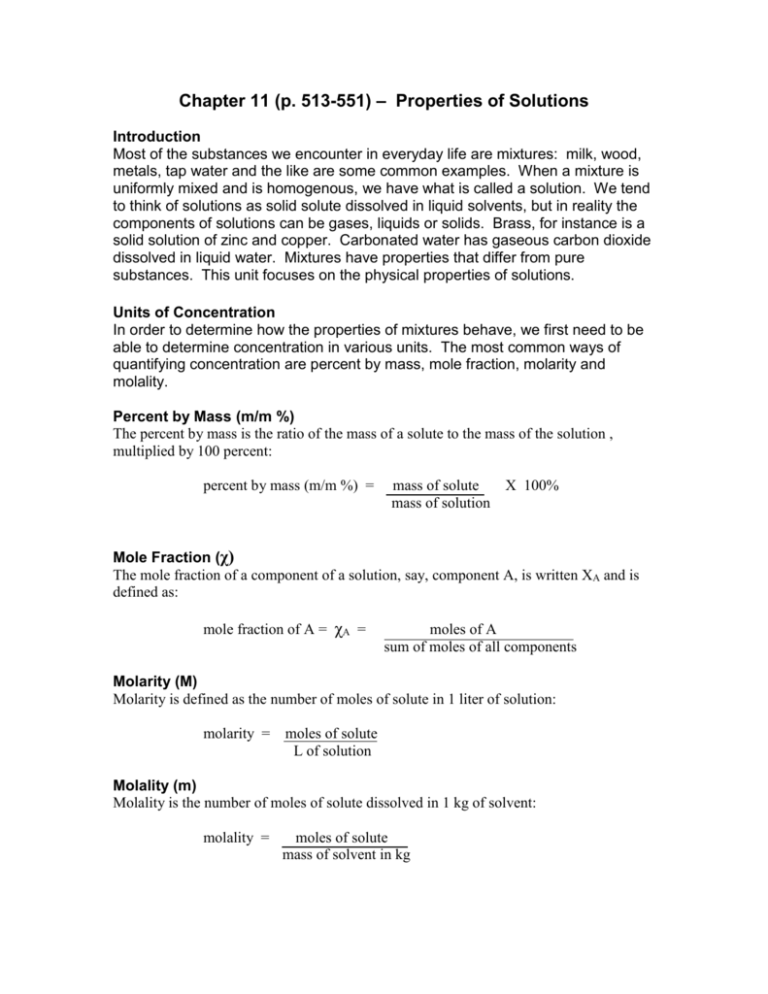Molality (m)
advertisement

Chapter 11 (p. 513-551) – Properties of Solutions Introduction Most of the substances we encounter in everyday life are mixtures: milk, wood, metals, tap water and the like are some common examples. When a mixture is uniformly mixed and is homogenous, we have what is called a solution. We tend to think of solutions as solid solute dissolved in liquid solvents, but in reality the components of solutions can be gases, liquids or solids. Brass, for instance is a solid solution of zinc and copper. Carbonated water has gaseous carbon dioxide dissolved in liquid water. Mixtures have properties that differ from pure substances. This unit focuses on the physical properties of solutions. Units of Concentration In order to determine how the properties of mixtures behave, we first need to be able to determine concentration in various units. The most common ways of quantifying concentration are percent by mass, mole fraction, molarity and molality. Percent by Mass (m/m %) The percent by mass is the ratio of the mass of a solute to the mass of the solution , multiplied by 100 percent: percent by mass (m/m %) = mass of solute mass of solution X 100% Mole Fraction (χ) The mole fraction of a component of a solution, say, component A, is written XA and is defined as: mole fraction of A = χA = moles of A sum of moles of all components Molarity (M) Molarity is defined as the number of moles of solute in 1 liter of solution: molarity = moles of solute L of solution Molality (m) Molality is the number of moles of solute dissolved in 1 kg of solvent: molality = moles of solute mass of solvent in kg EXAMPLE: Which of the following units of concentration will change when the temperature changes? m/m % mole fraction molarity molality Converting Between Units The only advice I can give you is pick a convenient amount of solution to consider, then reason your way through it. EX: The density of a 2.45 M aqueous solution of methanol (CH3OH) is 0.976 g/mL. What is the mass percent and molality of the solution? EX: Calculate the molality of a 35.4% by mass aqueous solution of phosphoric acid (H3PO4) Factors Affecting Solubility Before we even can describe the properties of a solution, we need to be able to predict when a solution can be made in the first place. Therefore, we need to known something about the solubility of the solute in the solvent. The Effect of Polarity on Solubiltiy You probably remember the old adage “like dissolves like”. This statement implies that polar substances are soluble in polar solvents, and nonpolar substances are soluble in nonpolar solvents. (In terms of solubility, ionic substances are generally considered soluble in polar substances, like water. Refer to solubility rules.) EX: Determine whether water or CCl4 would make a better solvent for the following: (a) SO2 (b) SO3 (c) grease (C20H42) (d) NaCl The Effect of Temperature on Solubility In general, temperature can affect solubility. As the temperature increases, solids tend to become more soluble (especially in liquid solvents) and gases tend to become less soluble. Gases also become more soluble when placed under increased pressure. Henry’s law states that the solubility of a gas in a liquid is proportional to the pressure of the gas above the liquid: P = kC P = partial pressure of the gas above the liquid k = Henry’s law constant (units are dependent on units of P and C) C = concentration (usually molarity) EX: A certain soft drink is bottled so that a bottle at 25 C contains CO2 gas at a pressure of 5.0 atm over the liquid. Assuming that the partial pressure of CO2 in the atmosphere is 4.0 X 10-4 atm, calculate the concentrations of CO2 in the soda both before and after the bottle is opened. The Henry’s law constant for CO2 in aqueous solution is 32 Latm/mol at 25 C. Colligative Properties Physical properties of solutions that depend upon the number, but not the type, of solute particles in a given amount of solvent are called colligative properties. The four colligative properties of a solution affect the solvent by: (1) (2) (3) (4) lowering its vapor pressure raising the boiling point lowering the freezing point generating osmotic pressure Lowering of Vapor Pressure and Raoult’s Law Experimental studies have shown that a solution containing a nonvolatile solute (one that doesn’t evaporate easily) has a lower vapor pressure than the pure solvent. Recall, the vapor pressure of a liquid is a measure of the pressure of the vapor, and it is also considered to be a measure of the tendency of a liquid to jump into the vapor phase. The lowering of vapor pressure associated with a nonvolatile solute is given by Raoult’s Law, which states that the vapor pressure of a solvent in a solution decreases as its mole fraction decreases. Mathematically, we have: Psolution = Xsolvent P˚solvent (where P˚solvent represents the vapor pressure of the pure solvent) EX: Sucrose is a nonvolatile solute in water. (a) Determine the vapor pressure of a solution made by dissolving 50.0 grams of sucrose (C12H22O11, molar mass = 342 g) in 117 grams of water at 25C. The vapor pressure of water at 25C is 23.8 torr. (b) If the solution was left unsealed for several days, what would happen to the vapor pressure over time? EX: Below is a vapor pressure of benzene graph. You probably recall that a liquid will boil when its vapor pressure equals atmospheric pressure. Vapor Pressure (torr) Vapor Pressure of Benzene 1500 1400 1300 1200 1100 1000 900 800 700 600 500 400 300 200 100 0 0 50 100 T (degrees Celcius) (a) What is the normal boiling point of benzene? (That’s the boiling point when atmospheric pressure equals 1.00 atm.) (b) What is the boiling point of benzene at a point where the atmospheric pressure is only 400 torr? (c) What is the heat of vaporization of benzene Hvap? (d) Show with a dashed line the effect of dissolving 1.0 mol of candle wax (C36H74) to 9.0 mol of benzene. Consider candle wax to be a nonvolatile solute. When a solution consists of two components that are very similar (called an ideal solution), each component behaves essentially as it would if it were pure. For example, the two liquids heptane and octane are very similar to each other. The next example illustrates this point. EX: At 40C, the vapor pressure of pure heptane is 92.0 torr and the vapor pressure of pure octane is 31.0 torr. Consider a solution that contains 1.00 mole of heptane and 4.00 moles of octane. Calculate the vapor pressure of each component and the total vapor pressure above the solution at 40C. Dissociation of Electrolytes and Colligative Properties Colligative properties depend on the number and not the type of particles dissolved in a solvent. But consider a solution made of 1.00 m NaCl. Recall that this solute will dissociate into Na+ and Cl- ions. The solution will have a particle concentration of 2.00 m if dissociation were complete. In truth, the sodium chloride ions are not 100% ionized. The van’t Hoff factor (i) is a measure of the dissociation of the substance. It is a number that tells you how many particles you get (on average) when 1 particle of the substance is dissolved. These van’t Hoff factors for several substances are given below. Substance sucrose (C12H22O11) KBr NaCl K2CO3 K2CrO4 van’t Hoff factor (i) 1.00 1.88 1.87 2.45 2.39 Boiling Point Elevation Hopefully, you recall that the boiling point of a liquid is the temperature at which the vapor pressure equals atmospheric pressure. Mathematically, we use: Tb = i Kbm Where Kb is called the molal boiling point elevation constant. It varies from solvent to solvent. For water, it is 0.52 C/m. EX: What is the boiling point of: (a) a 1.00 m aqueous sucrose solution, and (b) a 1.00 m aqueous NaCl solution. EX: Rank the following in order of increasing boiling point: 1.00 M NaCl, 1.00 M CaCl2, pure distilled water, 1.00 M HF, 1.00 M glucose Freezing Point Depression The freezing point depression calculation is very similar to the boiling point calculation. Mathematically we have: Tf = iKfm Where Kf is the molal freezing point depression constant, which varies from solvent to solvent. It has a value of 1.86C/m for water. EX: What is the freezing point of: (a) a 1.00 m aqueous sucrose solution, and (b) a 1.00 m aqueous NaCl solution. EX: Rank the following in order of increasing melting point: 1.00 M NaCl, 1.00 M CaCl2, pure distilled water, 1.00 M HF, 1.00 M glucose EX: A 1.20 gram sample of an unknown covalent compound is dissolved in 50.0 grams of benzene. The solution freezes at 4.92 C. Determine the molar mass of the unknown compound. Pure benzene freezes at 5.48 C, and has a Kf = 5.12 C/m. Osmotic Pressure Osmosis the diffusion of water through a semipermeable membrane. A semipermeable membrane will allow some substances (like water) to pass through, but not others. Water will diffuse until the pressure builds up enough to prevent further water flow. This pressure is called osmotic pressure. Mathematically, we have: = iMRT Where R is the ideal gas constant (use 0.0821 L atm/K mol) and M is the molarity. EX: What is the osmotic pressure of a 1.17 M sucrose solution? Assume room temperature (25°C). Colloids and the Tyndall Effect You may remember from first-year chemistry that many solutions are based on the size of the solute particle. Those with the largest particles are called suspensions and have solute particles that will settle out over time. An example would be muddy water. A colloid is a type of solution that has particles that are slightly smaller than a suspension. Colloid particles will not settle out over time and are believed to be stabilized by electrostatic repulsion. Milk is a good example of a colloid. A true solution has the smallest particles, like a solution of sodium chloride, for instance. Particles of a true solution, like those of a colloid, will not settle out over time. The first two solutions (suspensions and colloids) have particles that are large enough to scatter light that passes through. This scattering of light is known as the Tyndall Effect.








